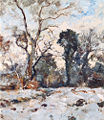Guillaume Vogels
Guillaume Vogels (born June 9, 1836 in Brussels , † January 9, 1896 in Ixelles ) was a Belgian painter . After training as a decorative painter, Vogels first turned to traditional landscape painting in dark colors and a realistic painting style, before using a lighter palette and a sketchy style of painting, influenced by contemporary artistic trends from France. Vogels is one of the main exponents of Belgian impressionism, particularly through his late work, characterized by melancholy autumn and winter landscapes in shades of gray. His work influenced the young James Ensor and other painters of the subsequent generation of artists.
Life
Little is known about the artist's early years. Vogels was born the son of a worker. After attending elementary school, he learned the profession of painter and decorator, which he completed in 1855 with the master's examination. For Vogels this profession was the first step towards his later career as a painter, since in the 19th century simple figurative decorative paintings, such as flower garlands or ornamental friezes, also belonged to the profession. He later ran a painting business in Brussels under the name Peinture et Décoration and bought his own house in nearby Ixelles . The Greek painter Périclès Pantazis also worked in this painting business , with whom Vogels was a close friend until his death in 1884. Influenced by Pandazis, who had previously studied the works of Gustave Courbet and Édouard Manet in Paris , Vogels turned to landscape and still life painting.
Around 1870 Vogels went to Paris, where he made contact with the painters of the artists of the Barbizon School . In Belgium he first took part in an art exhibition in Ghent in 1874 . In 1876 he took part in an exhibition at the Cercle Artistique in Brussels. The contemporary critics judged his work rather negatively and formulated comments such as “He whips his pictures with wrong color tones, he drums on his landscapes like a madman; this is ill-conceived impetus ”. In 1878 and 1881 he participated in exhibitions of the association La Chrysalide . Vogels achieved his international artistic breakthrough in 1880 when he took part in the Salon de Paris , where his painting Canal found general recognition in Holland .
In Brussels in particular, Vogels cultivated close friendships with avant-garde artists and art critics who influenced his style, which was independent of conventions. Together with his friend Pandazis, Vogels was one of the first members of the Les XX artists' association founded by the art writer Octave Maus in 1884 , which had a decisive influence on the development of Belgian painting at the end of the 19th century. Here Vogels also met James Ensor , who was more than twenty years his junior and whose early work was shaped by Vogels. Together with Ensor, Vogels probably went on a study trip to England in 1886. There is evidence that the two artists lived together in the Netherlands in 1892, during which they visited the museums of Amsterdam and Harlem together. At the third exhibition at Les XX , Vogels saw works by the French Impressionists for the first time, the choice of motifs being reflected in Vogels' later pictures. After Les XX was dissolved in 1893, Vogels repeatedly took part in the exhibitions of the artists' association La Libre Esthétique, which was also founded by Octave Maus . Vogels not only exerted considerable influence on Ensor, but also shaped the style of painters such as Willy Finch , Eugène Laermans and Théo van Rysselberghe . Vogels died on January 9, 1896 and was buried in the Ixelles cemetery.
plant
Vogels did not leave any written evidence that could provide information about his work and did not date his works, which makes it difficult to categorize his pictures. It was not until the major retrospective of his works in 1936 in the Palais des Beaux-Arts in Brussels that the exhibition curator Paul Colin was able to categorize his works in terms of time. Vogels' early work was shaped by the Belgian artists Louis Artan and Hippolyte Boulenger . For example, the paintings harbor mole in Ostend or the North Sea, thunderstorms, show parallels to traditional Belgian landscape painting , both in terms of color and choice of subject. A painting by Boulenger was also found in Vogels' private collection. His friend Pandazis brought him closer to contemporary French painting. In his late work there are again influences of the old masters Flemish painting, which led Vogels to his own interpretation of impressionism. In most of his works, Vogels eschewed distinctive colors and instead chose a variety of gray tones to design his pictures. This is particularly evident in his snowy landscapes in the last years of his life. His noticeably loose brushwork apparently anticipated the coming Expressionism.
Works (selection
literature
- Michèle Blondeel, Constantin Ekonomidès: Guillaume Vogels . Exhibition catalog Brussels and Ostend, Pandora Verlag, Antwerp 2000, ISBN 90-5325-227-4 .
- Götz Czymmek: Guillaume Vogels and Emile Claus, two Belgian impressionists . Exhibition catalog Wallraf-Richartz-Museum, Cologne 1988.
- Götz Czymmek (Hrsg.): Landscape in the light, impressionistic painting in Europe and North America . Exhibition catalog Wallraf-Richartz-Museum, Cologne 1990.
- Robert Moyens: Guillaume Vogels 150 Jaar . Exhibition catalog Herman Teirlinck Huis, Beersel 1986.
Individual evidence
- ↑ idol Czymmek: Guillaume Vogels and Emile Claus, two Belgian Impressionists . Page 26.
Web links
| personal data | |
|---|---|
| SURNAME | Vogels, Guillaume |
| BRIEF DESCRIPTION | Belgian painter |
| DATE OF BIRTH | June 9, 1836 |
| PLACE OF BIRTH | Brussels |
| DATE OF DEATH | January 9, 1896 |
| Place of death | Ixelles |








